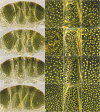The importance of being integrative: a remarkable case of synonymy in the genus Viridiscus (Heterotardigrada: Echiniscidae)
- PMID: 34801080
- PMCID: PMC8605589
- DOI: 10.1186/s40851-021-00181-z
The importance of being integrative: a remarkable case of synonymy in the genus Viridiscus (Heterotardigrada: Echiniscidae)
Abstract
There are two predominant sources of taxonomically useful morphological variability in the diverse tardigrade family Echiniscidae: the internal structure and surface sculpture of the cuticular plates covering the dorsum (sculpturing) and the arrangement and morphology of the trunk appendages (chaetotaxy). However, since the appendages often exhibit intraspecific variation (they can be reduced or can develop asymmetrically), sculpturing has been considered more stable at the species level and descriptions of new echiniscid species based solely on morphology are still being published. Here, we present a case study in which a detailed analysis of the morphology and multiple genetic markers of several species of the genus Viridiscus shows that cuticular sculpture may also exhibit considerable intraspecific variation and lead to false taxonomic conclusions. In a population collected from the eastern Nearctic, in the type locality of the recently described species V. miraviridis, individuals with transitional morphotypes between those reported for V. viridissimus and V. miraviridis were found. Importantly, all morphotypes within the viridissimus-miraviridis spectrum were grouped in a single monospecific clade according to rapidly evolving markers (ITS-1, ITS-2 and COI). Given the morphological and genetic evidence, we establish V. miraviridis as a junior synonym of V. viridissimus. This study explicitly demonstrates that a lack of DNA data associated with morphological descriptions of new taxa jeopardizes the efforts to unclutter tardigrade systematics. Additionally, V. perviridis and V. viridissimus are reported from Lâm Đồng Province in southern Vietnam, which considerably broadens their known geographic ranges.
Keywords: DNA barcoding; Dorsal sculpturing; Integrative taxonomy; Junior synonym; Nearctic.
© 2021. The Author(s).
Conflict of interest statement
The authors declare that they have no competing interests.
Figures



Similar articles
-
Green armoured tardigrades (Echiniscidae: Viridiscus), including a new species from the Southern Nearctic, exemplify problems with tardigrade variability research.Sci Rep. 2023 Sep 28;13(1):16329. doi: 10.1038/s41598-023-40609-4. Sci Rep. 2023. PMID: 37770488 Free PMC article.
-
Rough backs: taxonomic value of epicuticular sculpturing in the genus Milnesium Doyère, 1840 (Tardigrada: Apochela).Sci Rep. 2022 Jun 14;12(1):9857. doi: 10.1038/s41598-022-10758-z. Sci Rep. 2022. PMID: 35701458 Free PMC article. Review.
-
Two new species of Tardigrada from moss cushions (Grimmia sp.) in a xerothermic habitat in northeast Tennessee (USA, North America), with the first identification of males in the genus Viridiscus.PeerJ. 2020 Nov 23;8:e10251. doi: 10.7717/peerj.10251. eCollection 2020. PeerJ. 2020. PMID: 33282552 Free PMC article.
-
Variability of Echiniscus tristis Gąsiorek & Kristensen, 2018-is morphology sufficient for taxonomic differentiation of Echiniscidae?Zootaxa. 2019 Nov 26;4701(1):zootaxa.4701.1.1. doi: 10.11646/zootaxa.4701.1.1. Zootaxa. 2019. PMID: 32229964
-
Untangling the Echiniscus Gordian knot: paraphyly of the "arctomys group" (Heterotardigrada: Echiniscidae).Cladistics. 2019 Dec;35(6):633-653. doi: 10.1111/cla.12377. Epub 2019 Mar 22. Cladistics. 2019. PMID: 34618946
Cited by
-
Three new species of Mesobiotus (Eutardigrada: Macrobiotidae) from Sweden with an updated phylogeny of the genus.Sci Rep. 2025 Feb 6;15(1):4535. doi: 10.1038/s41598-025-88063-8. Sci Rep. 2025. PMID: 39915525 Free PMC article.
-
Patterns of sexual dimorphism in the armoured tardigrades.Biol Lett. 2024 Sep;20(9):20240301. doi: 10.1098/rsbl.2024.0301. Epub 2024 Sep 11. Biol Lett. 2024. PMID: 39255843
-
Morphological and genetic variability in cosmopolitan tardigrade species-Paramacrobiotus fairbanksi Schill, Förster, Dandekar & Wolf, 2010.Sci Rep. 2023 Oct 17;13(1):17672. doi: 10.1038/s41598-023-42653-6. Sci Rep. 2023. PMID: 37848470 Free PMC article.
-
Green armoured tardigrades (Echiniscidae: Viridiscus), including a new species from the Southern Nearctic, exemplify problems with tardigrade variability research.Sci Rep. 2023 Sep 28;13(1):16329. doi: 10.1038/s41598-023-40609-4. Sci Rep. 2023. PMID: 37770488 Free PMC article.
-
Rough backs: taxonomic value of epicuticular sculpturing in the genus Milnesium Doyère, 1840 (Tardigrada: Apochela).Sci Rep. 2022 Jun 14;12(1):9857. doi: 10.1038/s41598-022-10758-z. Sci Rep. 2022. PMID: 35701458 Free PMC article. Review.
References
-
- Fontoura P, Bartels PJ, Jørgensen A, Kristensen RM, Hansen JG. A dichotomous key to the genera of the marine heterotardigrades (Tardigrada) Zootaxa. 2017;4294(1):1–45. doi: 10.11646/zootaxa.4294.1.1. - DOI
-
- Møbjerg N, Jørgensen A, Kristensen RM, Neves RC. Morphology and functional anatomy. In: Schill RO, editor. Water bears: the biology of tardigrades. Zoological Monographs; 2018. p. 57–94, DOI: 10.1007/978-3-319-95702-9_2.
-
- Richters F. Tardigrada. In: Kükenthal W, Krumbach T, editors. Handbuch der Zoologie, vol. 3: Walter de Gruyter & Co.; 1926. p. 58–61.
-
- Marcus E. Zur Anatomie und Ökologie mariner Tardigraden. Zool Jahrb Abt Syst. 1927;53:487–558.
Grants and funding
LinkOut - more resources
Full Text Sources

